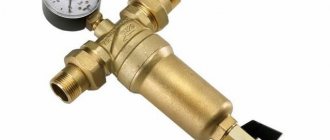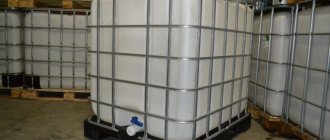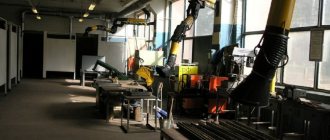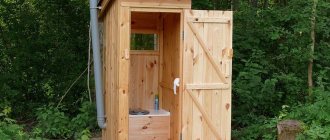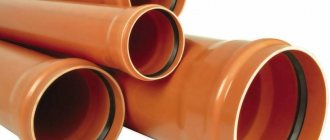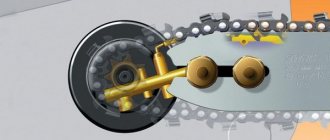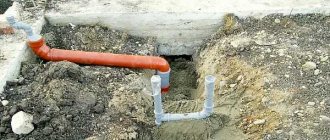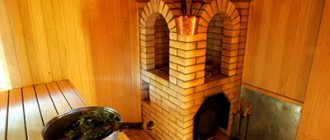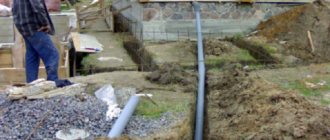Exhaust and ventilation in the garage will protect against many problems that arise in the absence of such an element. Toxins gradually accumulate indoors, poisoning the body. If at first the concentration of vapors from fuel combustion is insignificant, then over time these substances cause headaches, lethargy and other signs of intoxication.
Another reason for mandatory ventilation is excessive humidity. It leads to the destruction of metal parts of the car and causes corrosion. The building itself also suffers from this - the walls and supports lose their strength, and mold forms on the surface.
How to properly ventilate a garage
The right decision is to develop a diagram at the design stage of the building. This is due to the fact that during the construction of a building it is more convenient to create functional openings in the walls and ceiling. The area, height of the walls, number of floors and number of cars for which the room is designed are taken into account. These factors determine the type of exhaust device that will provide ventilation in the best possible way.
All ventilation systems can be divided into 3 types:
- Natural. This design is based on the principles of aerodynamics, air flows circulate freely without any external intervention.
- Mechanical or forced. Automatic equipment is used to ensure perfect ventilation.
- Combined - a combination of the first two types. The independent movement of flows is complemented by the action of specialized equipment.
Outlet and inlet paths are assembled from metal, asbestos or plastic pipes. To select the required diameter, an assessment of the gas volumes in the room is required. According to current standards, it is calculated according to the following principle: 1.5 cm of pipe diameter per 1 square meter of area. For example, if the size of the building is 10 square meters. m., then to arrange the entire structure you will need 2 pieces of pipe with a diameter of 15 cm.
Another method of calculating ventilation is used, which is more suitable for installing a single-channel automated system. According to this formula, the third part of the area should correspond to the total size of the ventilation holes.
Garage ventilation diagram
How to make a hood in a garage
To install the structure yourself, you need to follow these steps:
- Step back 15-20 cm in height from the floor.
- Use a hammer drill to make a hole in the wall to bring in fresh air.
- Insert a piece of pipe and cover the area around it with plaster.
- Use a hammer drill to create a space in the ceiling, or step back from it 15-20 cm down the wall. Polluted air will escape into it.
- Insert the pipe into the prepared place in the roof. The longer it is, the more effective the air change will be. Cover its outer end with a cone-shaped dome to protect it from precipitation.
In a metal garage, you can make the simplest and cheapest option: in selected places, drill holes like a lattice with a drill, cover them with a mesh.
Installation of a structure for exhaust gas extraction indoors is a mandatory requirement of SNiP 02/21/99. To choose the right type, you should understand the work of each of them.
Garage ventilation system
DIY hood installation
Homemade exhaust hood for a welding table in a garage made of plastic pipes
According to the rules and requirements for safety standards, in large welding rooms with several stations, the ventilation system must be installed by qualified specialists who can make accurate calculations. In small workshops, you can create an air exchange system yourself according to drawings, following standard instructions. In this case, the work is divided into two stages. First of all, a supply-type hood is installed, using a mixed type of air supply and outlet in horizontal and vertical modes; the second option is more preferable:
- A ventilation chamber is installed near the wall with access to the street, in which a fan is installed, equipped with the functions of filtering, cooling and heating air.
- A hole is made in the wall through which the fan will draw in fresh air.
- A channel is laid from the ventilation chamber to the ceiling to supply air.
- An additional fan equipped with air purifying filters is installed in the attic. A special pipe is installed from it to the roof, removing exhaust air masses.
- Two or three holes are made in the ceiling, which are connected to the attic fan using ventilation ducts.
When the general air exchange system is ready, you can begin installing the local line. Ventilation for a welding station of this type is a suction structure, from which a channel is laid towards the roof. It is selected taking into account the configuration of the production enterprise for a specific workshop.
Local exhaust hood is able to remove most of the contaminants autonomously, preventing their spread throughout the room. If necessary, install a mobile suction unit that moves the hood together with the welding machine.
Natural ventilation in the garage
If there is a cellar inside the building, then it must be equipped with a separate exhaust system (read more about this here). The inspection hole does not apply to this rule - its size is taken into account when calculating the total area.
To make good ventilation, you need to rely on the following factors:
- the volume of air that needs to be changed;
- wind direction and frequency of its changes;
- temperature levels in the region and their differences depending on the season.
The temperature difference between inside and outside is of great importance. The air in the room should be warmer, and therefore lighter - then it will be easily replaced by heavier air. Fresh flows will penetrate through the air duct independently, without the intervention of mechanical systems, replacing less dense air masses.
Also, the effectiveness of this type of design depends on different pressure indicators between the vertical position of the inlet and outlet. The difference between the inlet and outlet must be at least 3 meters.
If these conditions were not met when installing a natural type hood, the structure will not fully perform its functions. During the cold season, heating will be required to establish the temperature difference between inside and outside. The incoming flow should be reduced by adjusting the opening of the duct. In summer, the ventilation passage opens completely, and circulation is ensured by the direction of the wind.
Such a homemade garage hood will not cost much, but its efficiency is not high enough. Acceptable air circulation will be observed only when the outside temperature is below +10 degrees. A draft can also be created, which can negatively affect health. Pipes require regular cleaning: in summer - from dust, in winter - from ice.
Examples of self-calculation
It is important to consider the following:
- To ensure respiratory protection, it is necessary to pump out the contaminated atmosphere from the working area at a flow rate of at least 1.5 m/sec. The requirement is described in the GOST 12.3.003-86 standard, which allows the use of movable nozzles connected to the pumping station with an elastic hose.
- If semi-automatic welding is intended, then it is necessary to provide a crevice nozzle with a slot length of 350 mm, located at a distance of 50 mm from the working area. If the design of the equipment or equipment is not designed for the installation of a slotted socket, then it is necessary to provide several standard outlets.
We recommend reading: How to make an oscillator yourself
To determine the required volume of air, use an equation of the form L=K*a, where:
- K – coefficient equal to the cube root of 12 or 16 (for a single slotted element and several pipes, respectively);
- a is the current strength in the circuit (in A).
When making an updated calculation, it is necessary to focus on the technology of work.
For example, when using electrodes with a protective coating, it is necessary to provide a supply of 4500 m³/hour for each kilogram of burnt rods. Coefficients and methods for calculating the performance of a ventilation system are given in the regulatory documentation of GOST and SNiP. It should be remembered that using the method of free recirculation of flows to purify indoor air is strictly prohibited.
Forced ventilation in the garage
The mechanical type of hood works much more efficiently - it provides complete and rapid ventilation. Before installing it, you do not need to calculate the area of the room, since the influx does not come independently, but through the built-in fans for ventilation in the garage. The system replaces air masses throughout the entire volume, including the inspection pit and cellar.
To do this, you need to purchase high-quality equipment and provide it with power from the mains. This is the only disadvantage of the system - the purchase of exhaust and supply modules. They are expensive, but the inside will always be dry and warm.
In the case of arranging an underground garage, only a mechanical ventilation method is suitable.
The need for ventilation in a welding room
The welder's workplace is equipped with additional hoods.
Welding work is classified as a hazardous process due to the release of many hazardous substances, including oxides of iron, chromium and manganese, fluorine compounds and silicon dioxide. They are dangerous to human health and harm the environment, so every room where welding is carried out on an ongoing basis is supplemented with hoods.
Ventilation of a welding shop solves several main problems:
- removal of chemical components that pose a threat;
- creating and maintaining an optimal microclimate indoors, taking into account its temperature, humidity and in accordance with GOST and SNiP standards;
- continuous supply of oxygen.
Air exchange in workshops, welding areas and posts must be carried out autonomously. If an industrial welding room is located in the same building as others, they do not have combined ventilation. It is also not recommended to design systems with cyclic and repeated use of air masses. During the work, a natural system is not used, since there is no significant heat generation in this case. Before being supplied inside the space, the air is brought to the required temperature, taking into account the weather conditions outside.
In addition to installing a hood, various means are used to protect welders from radiation, including thermal insulation of heated surfaces and shielding. Thermal insulation work is considered the most effective way to reduce the intensity of rays and prevent possible burns. Special materials and structures, such as concrete, brick, asbestos and felt, are used to equip workplaces in combination with screens or separately from them.
Combined ventilation
Such a system has good efficiency, while making it possible to save on equipment and electricity.
Separately, you can create a ventilation system for the inspection pit
The principle is the distribution of air flows: one of them is natural, and for the other an automatic mechanism is used.
You need to install an exhaust fan in the outlet hole - it will free up space by sucking waste material out. Fresh ones will fill the free volume that appears naturally. In this design, the location of the inlet and outlet passages does not matter: they can be mounted where it is convenient.
The disadvantage of a combined ventilation device is the need to constantly turn the equipment on and off. It is easy to solve the problem using programmable equipment with a timer, but you will have to spend money on such equipment. Another disadvantage: the wind flows inside naturally, which means it is not heated or purified. Because of this, the exhaust device will periodically become clogged, which requires regular cleaning and preventive measures.
Regulatory mechanism for local ventilation
According to sanitary standards N 1009-73, a number of requirements are put forward for the device of local ventilation:
- local suction must be installed at stationary and non-stationary welding stations;
- when manual welding, the workplace must be supplemented with rotary-lifting panels, the bottom of which should be no higher than 350 mm from the welding machine;
- when welding medium-sized products, it is necessary to install a fume hood, which is a type of local suction;
- the air speed when using manual welding and a device powered by carbon dioxide must be more than 0.5 m/s and 0.3 m/s when welding in inert gases;
- fume hoods must localize up to 90% of harmful substances from air masses, other types of local ventilation - up to 75%;
- 10-25% of harmful components in the air must be eliminated using a general ventilation system.
Hood in the garage for proper ventilation
The garage is a special space to which increased demands should be made. Here it is necessary to ensure not only decent thermal insulation and waterproofing, but also effective ventilation. This is of great importance for the safety of the car and the protection of metal from corrosion. It is extremely important to prevent condensation from forming. And for this you need a good hood in the garage.
Ventilation will always allow you to remove excess moisture in a timely manner. Today we will look at how to make a hood in the garage with your own hands so that everything works efficiently and economically, without failures. We will find out what types of ventilation systems there are, how to arrange everything efficiently. We will pay special attention to the hoods in the garage, located above the painting area and in the cellar.
Is it possible to leave a garage without a hood?
Some car enthusiasts, unfortunately, do not pay due attention to the ventilation system. And they believe that it is quite possible to do without it; there is no need for an exhaust hood in the garage, especially if the room is well heated and has decent waterproofing.
- In fact, it is necessary to install an effective exhaust hood in the garage and take care of the uninterrupted operation of the ventilation system as a whole. We will indicate only the most significant factors.
- When a car is left in a garage for a long time, the likelihood of metal corrosion is high. Only ventilation will help to eliminate all excess moisture in a timely manner, especially in winter.
- If it is raining outside, the humidity level is simply high, or it is cold enough there, which is why there is a strong temperature difference between the outside and inside the garage, the car ends up wet. It is extremely difficult to wipe everything perfectly. When ventilation works well, moisture evaporates on its own.
- Of course, flammable materials and items that can cause toxic fumes are stored in the garage. In addition, garage workers can paint their cars and carry out repair work. And here you simply cannot do without a good hood to ensure safety and comfort.
The conclusion is clear: a garage hood is necessary.
Ventilation schemes in the garage
If you decide to make a hood in your garage yourself, first you need to decide on the type of ventilation system. Nowadays, three common options are most often used.
- You can install a hood using mechanical devices. Such ventilation will be forced.
- Some try to make a natural ventilation system.
- A good solution is to design combined ventilation.
Natural exhaust is done quite quickly, and the installation process is not so complicated and does not require significant investments. True, the efficiency of such ventilation is also not so high. The hood works only due to the temperature difference between the outside and inside of the garage. This system is not very suitable for buildings made of brick and foam blocks, as well as cellars.
The mechanical hood works thanks to the installed fan. Its effectiveness will already be significantly higher. When a combined option is used, it is possible to ensure effective air outflow by installing a fan, but stimulate the influx of air flow naturally.
Exhaust devices for welding
Industrial cantilever hood Afalina
Hoods for welding in production are divided into several available varieties. The most popular are devices with a lift-and-swivel design. They consist of an air receiver, which can be fixed in any position using hinges, as well as a hose connecting the air receiver and the central exhaust system. This design makes it possible to eliminate 85% of substances hazardous to health, since it can be placed close to any welding machine. Hoods help to completely purify the air at a distance of up to 8 meters from the installation site. Users note such models as “Fallow deer” and “Octopus”.
In second place in demand are local suction units, which must be installed at a height of up to 1.5 meters from the welder’s position.
The hood above the working welding table can be external or internal; in the second case, it is connected to the general ventilation system using special hoses. To ensure proper air circulation, it is better to give preference to supply exhaust ventilation, providing an influx of air masses at a speed of over 40 m3/hour.
Mechanical hood: do it yourself
Let's look at how to make a hood in a garage using a mechanical fan. In this way, forced ventilation is installed with a fairly high level of efficiency. The entire space will be well ventilated, the air will be clean and fresh, which is especially important in the garage. In addition, a normal atmosphere will be established in the inspection hole and in the cellar.
Experienced garage workers note that such forced ventilation can be very successfully combined with heating the room. To do this, install heating elements on the inlet openings. And not only fresh, but also heated air flow enters the room.
There are two significant factors to take into account here.
- Protected electrical cables must be connected to the exhaust openings in advance to ensure uninterrupted power supply to the fan.
- The inlet opening must be mounted from above. But the hood is located on the opposite side.
Mechanical forced ventilation is an excellent option for increasing efficiency.
We provide natural ventilation in the garage
Now we’ll find out how to properly make a hood in a garage if you choose a natural ventilation system. It will be necessary to ensure normal air circulation, and for this the difference in pressure between cold and warm air flows must be maintained at all times. It is necessary to arrange two ventilation ducts in accordance with certain rules. And it is best to organize such a ventilation system during the construction of the garage. Remember important tips.
- The hole for the flow of air from the street is located at a distance of 100 mm from the floor. The hood itself should be at a distance of 300 mm from the floor.
- It is very important to protect the ventilation system from various rodents, insects, and all kinds of debris. To do this, special fine grilles and mesh are installed on the ventilation openings.
- You can supplement the system with a deflector. It will provide a difference in pressure and significantly increase the efficiency of ventilation. The deflector must be additionally insulated so that condensation does not accumulate on it.
Unfortunately, natural hood has several significant disadvantages that should not be forgotten.
- When people are in the garage, a draft can be felt strongly between the two openings for the outflow and inflow of air.
- On hot days, such ventilation practically does not function, since there is no necessary temperature difference, and sometimes it is even cooler in the garage than outside.
- Ventilation must be thoroughly cleaned regularly to remove accumulated dust and debris.
Find out more about other options for garage ventilation to choose the best option.
Requirements for hood equipment
Ventilation in the welding shop is arranged in accordance with the requirements of sanitary rules 1009-73 and SNiP II-33-75. The documentation indicates the permissible concentrations of harmful substances, dimensions and productivity of the equipment (depending on the number of workers, area of the premises, type of welding equipment and production volumes). Separate sections of the rules regulate the cross-section and position of the gas exhaust channels (the distance from the area affected by the arc on the surface to the ventilation pipe should not exceed 50 mm).
Primary requirements:
- Installation of local suction at each post (regardless of category). In the case of connecting small-sized parts, it is necessary to organize the workbench in a fume hood.
- If manual technology is used, it is necessary to provide rotating or lifting ventilation panels. The distance from the working area to the air channel should not be less than 350 mm.
- The air flow circulation speed when performing work with electrodes with a protective coating is not lower than 0.5 m/sec. When supplying a protective gas environment, the parameter is reduced to 0.3 m/sec (to prevent rupture of the atmosphere around the arc and the melt bath).
- When performing work in a fume hood, at least 90% of impurities must be separated from the air. Other local ventilation units remove up to 75% of foreign particles. The remaining gases and vapors are removed from the room by a general ventilation system.
- The equipment must maintain the concentration of harmful impurities in accordance with the requirements of GOST 12.1.005-88. The content of foreign elements in the atmosphere at a distance of 4 m from the work site should not exceed the maximum permissible concentrations.
Recommended reading: Choosing a chameleon mask
There should be a hood at every post.
Forced ventilation
Of course, it is forced ventilation that allows you to increase the efficiency of air exchange in the garage. To set up a functional, effective system, you need to stock up on the following equipment.
- A supply mechanism is needed. You will need a fan, heater and filter.
- Extraction equipment must be used. You can make one channel for air outflow, or two hoods at once.
The air mass in the supply mechanism is heated and then cleaned by a filter. Then the air is distributed throughout the system. An axial fan will be able to remove dirty air to the street, and the already purified air into the garage. You can ensure even distribution of air throughout the garage thanks to ducted air ducts.
Scheme of general ventilation of the welding shop
The ventilation grille, the size of which is 23.5x43.5 mm with a hole diameter of 50 mm, provides fresh air at a speed of 4.5 m/s. Air masses, dissecting as they pass through the grille, rise vertically and cover the entire room. The speed of air movement in the workshop corresponds to 0.1 m/s, which makes it possible to eliminate all harmful components in the air. Air exchange in the room is ensured by fans installed under the floor, with a total capacity of 3400 m3/hour. Exhaust air is eliminated using fans installed on the roof with a total capacity of 6600 m3/hour. When the system operates for 20 minutes, all contaminated air masses are eliminated, and the concentration of harmful substances in the air is reduced to 2 mg/m3.
Combined ventilation: making an effective exhaust hood in the garage
If you still choose a combined ventilation system, you can quickly smooth out all the disadvantages of natural ventilation and at the same time fit into a modest budget. You will need to use an electric exhaust fan. You can make roof fans by installing them on the roof. Another option is to attach fans to the walls, making them axial.
There is an interesting solution: some practical garage workers install windmills on the structure. Then, if there is wind, you can turn off the electric fan completely, achieving maximum savings.
A good solution is to supplement the system with a timer to constantly regulate its operation. This will ensure safety and savings.
Hood in the garage basement
It is important to take care of good ventilation in the basement or garage cellar. This will prevent the formation of fungus, mold, and condensation. Since the cellar in the garage usually has a small area, car enthusiasts prefer to limit themselves to a natural ventilation system. The hood is installed at the top, and the channel for air flow is at the bottom.
It is necessary to make air ducts for air inflow and outflow. The end of the pipe lowered into the garage basement should be at a maximum distance of 20 cm from the floor. The other end of the pipe is brought out. The exhaust air is discharged to the roof: there the air duct should protrude above the roof.
Experts note that when installing ventilation and hoods in the basement cellar, it is necessary to reduce the number of turns and bends to a minimum. Each bend reduces the efficiency of the ventilation system. In addition, remember to protect the hoods with grilles.
Calculation of a ventilation system for a welding shop
Calculation of the performance of the ventilation system for a welding shop should be carried out depending on the number of electrodes used per 1 working hour:
- manual welding method – for 1 kg of electrodes it is necessary to ensure a productivity of up to 4500 m3/hour;
- semi-automatic welding method - for 1 kg of electrodes it is necessary to ensure a productivity of up to 2 m3/hour.
Important! When working using the semi-automatic method, one worker can use more than 5 kg of electrodes, respectively, productivity increases by a multiple of the material used.
For the ventilation system to be effective, it is necessary to install powerful fans that are fixed outside the workshop. Ventilation ducts are installed using metal pipes. Ventilation grilles should be located near the welder’s workplace.
When installing an exhaust system, it is allowed to install special filters that allow the use of air recirculation in the workshop. There, the emission of harmful welding gases into the atmosphere is eliminated.
The welding shop ventilation system must provide fresh air to the shop and remove stale air. It is designed at the initial stage of construction.
Ventilation above the painting area
Car enthusiasts often repair and paint cars in the garage. Of course, the dyeing process releases quite a lot of toxic compounds that are potentially hazardous to health. It is important to provide this area with additional hood. At the same time, experts and more forward-thinking garage workers note that the ventilation system above the painting area should also be equipped with filters.
Please note: forced exhaust must be done above the painting area. Natural ventilation in such a dangerous place will not be enough, since its efficiency is quite low. The air must be cleaned of harmful chemical compounds as quickly as possible.
The most successful solution is to install a forced ventilation system with two fans. One fan will enhance the outflow of polluted air, and the other will actively pump in clean air. It is better to install filters on both air ducts, for outflow and inflow.
It is also important to ensure normal conditions for the work itself in the garage. For example, when the body is being painted, any tiny speck that comes from the air instantly stands out on the fresh paint. That is why the floor in the garage must be moistened before work, and the inlet must be reliably protected by a filter. Then particles of litter and dust will not penetrate into the room.
When a hood with a filter is installed correctly, it will prevent harmful toxic fumes from entering the atmosphere. Remember also about the correct location of the air ducts. The exhaust duct is located at the bottom, but the hole for the flow of fresh air is mounted under the ceiling of the garage room. Then harmful vapors will fall down and immediately and quickly be eliminated from the garage.
Types of ventilation
The design and performance of the exhaust device depend on the dimensions of the parts being connected and the intensity of the work. When welding wide and extended seams, the amount of gases entering the atmosphere increases.
It is not recommended to place an umbrella above a work table (similar to kitchen hoods), since the operator will inhale harmful substances drawn in by the air flow.
Local exhaust
To remove gases from the working area, it is necessary to install a grate with a channel located below. The ventilation system includes a filter with a mesh to extinguish sparks and catch droplets of molten metal and flux. The productivity of an electrically driven fan reaches 5.5 thousand m³/hour (depending on the volume of the workshop and the amount of gases). If it is impossible to install a grill on the table, then use mobile filter-ventilation units with flexible hoses connected to the work area.
Local exhaust on the welding table.
When connecting parts of complex geometric configurations, installations with rotating or lifting air intakes are used. A console with a drum is mounted on the ceiling, on which a flexible hose with a diameter of up to 200 mm is wound.
The welder manually brings the ventilation socket to the working area and fixes it in a given position. Fresh air is supplied to the lower part of the workshop. It is allowed to organize its upward flow with forced removal to the welder’s workplace.
General ventilation
The system includes separate ventilation units that ensure the exchange of air masses in the room. Filtration equipment is provided to separate foreign particles. Such equipment should provide the workshop with fresh air, taking into account the maximum productivity of the installed equipment. The standards provide for the organization of a general exchange system when using from 200 g of electrode material per 1 hour of working time per 1 m³ of room volume. If these parameters are lower, air exchange is provided naturally.
Scheme of general ventilation.
The standards provide for maintaining 10-fold air exchange in rooms, ensuring a flow rate of circulation in the vertical direction of 0.1 m/sec (to remove dust and gases from areas located outside the welding stations).
If the equipment is used in winter, the ventilation system must maintain the air temperature in the workshops at least +18°C. For heating, heat guns or radiators installed in ventilation ducts are used.
Options for Confined Spaces
To organize air exchange in such rooms, use:
- A system of forced supply of purified atmosphere with simultaneous removal of contaminants throughout the entire volume.
- Removal of harmful substances from the working area while ensuring air exchange naturally through ventilation slots.
- Ventilation of the area near the welder’s respiratory organs (for example, by forced supply of purified atmosphere under a mask or shield).
We recommend reading: Do-it-yourself reliable plasma cutter. Instructions
When carrying out work in enclosed spaces, it is necessary to use high-pressure fans with increased productivity and elastic hoses. The hoses are connected with sealed couplings that can withstand a given flow pressure. In winter, heating is provided. The flow speed for manual welding should be in the range of 0.7-2.0 m/sec. The direction of circulation ensures the removal of harmful gases from the respiratory system. If 2 welders are expected to work, then it is necessary to ensure the dispersion of impurities to MPC values.
Circulation in closed environments is improved by using a contaminant drainage system. To prevent metal particles and smoke from entering the room, it is necessary to pump out 10-15% more air than is supplied through the discharge channel.
In addition to stationary installations, the use of mobile units is allowed (for example, when welding tanks or other containers in open space).


